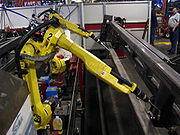
Robot welding
Encyclopedia

Robot
A robot is a mechanical or virtual intelligent agent that can perform tasks automatically or with guidance, typically by remote control. In practice a robot is usually an electro-mechanical machine that is guided by computer and electronic programming. Robots can be autonomous, semi-autonomous or...
s), which completely automate a welding
Welding
Welding is a fabrication or sculptural process that joins materials, usually metals or thermoplastics, by causing coalescence. This is often done by melting the workpieces and adding a filler material to form a pool of molten material that cools to become a strong joint, with pressure sometimes...
process by both performing the weld and handling the part. Processes such as gas metal arc welding
Gas metal arc welding
Gas metal arc welding , sometimes referred to by its subtypes metal inert gas welding or metal active gas welding, is a semi-automatic or automatic arc welding process in which a continuous and consumable wire electrode and a shielding gas are fed through a welding gun...
, while often automated, are not necessarily equivalent to robot welding, since a human operator sometimes prepares the materials to be welded. Robot welding is commonly used for resistance spot welding and arc welding
Arc welding
Arc welding is a type of welding that uses a welding power supply to create an electric arc between an electrode and the base material to melt the metals at the welding point. They can use either direct or alternating current, and consumable or non-consumable electrodes...
in high production applications, such as the automotive industry.
Robot welding is a relatively new application of robotics
Robotics
Robotics is the branch of technology that deals with the design, construction, operation, structural disposition, manufacture and application of robots...
, even though robots were first introduced into US industry during the 1960s. The use of robots in welding did not take off until the 1980s, when the automotive industry began using robots extensively for spot welding. Since then, both the number of robots used in industry and the number of their applications has grown greatly. In 2005, more than 120,000 robots were in use in North American industry, about half of them for welding. Growth is primarily limited by high equipment costs, and the resulting restriction to high-production applications.
Robot arc welding has begun growing quickly just recently, and already it commands about 20% of industrial robot applications. The major components of arc welding robots are the manipulator or the mechanical unit and the controller, which acts as the robot's "brain". The manipulator is what makes the robot move, and the design of these systems can be categorized into several common types, such as the SCARA robot and cartesian coordinate robot
Cartesian coordinate robot
A cartesian coordinate robot is an industrial robot whose three principal axes of control are linear and are at right angles to each other. Among other advantages, this mechanical arrangement simplifies the Robot control arm solution...
, which use different coordinate systems to direct the arms of the machine.
The robot may weld a pre-programmed position, be guided by machine vision, or by a combination of the two methods.
The technology of signature image processing
Signature image processing
Weld monitoring, testing and analysis here refers primarily to technological methods and actions to test or assure the quality of welds, and secondarily to technological methods to confirm the presence, location and coverage of welds...
has been developed since the late 1990s for analyzing electrical data in real time collected from automated, robotic welding, thus enabling the optimization of welds.

